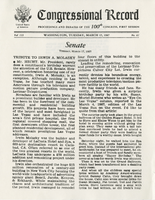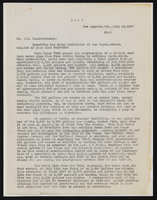Search the Special Collections and Archives Portal
Search Results
Audio clip from interview with Greg Goussak on May 19, 2015
Date
Archival Collection
Description
In this clip, Greg Goussak describes his family's involvement with the Albert Einstein Hebrew Day School where his mother was the director in the 1970s.
Sound
Audio recording clip of interview with Lucille Bryant by Claytee D. White, December 13, 1995
Date
Archival Collection
Description
Part of an interview with Lucille Bryant conducted by Claytee D. White on December 13, 1995. In the clip, Bryant compares economic opportunities in Tallulah and Las Vegas in the 1950s.
Sound
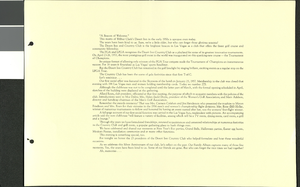
Desert Inn Country Club family album, page 01
Description
Printed text about the Desert Inn Country Club. The paragraph reads: "'A Beacon of Welcome.' This motto of Wilbur Clark's Desert Inn in the early 1950s is apropos even today. The years have been kind to us. Sure, we're a little older, but who can forget those glorious seasons? The Desert Inn and Country Club is the brightest beacon in Las Vegas as a club that offers the finest golf course and community fellowship. The PGA and LPGA recognizes the Desert Inn Country Club as a playland for some of its greatest innovative tournaments. On April 23-26, 1953, the most prestigious golf event in the world was inaugurated on this spanking-new course - the Tournament of Champions. Its unique format of allowing only winners of the PGA Tour compete made the Tournament of Champions an instantaneous success. For 16 years it flourished as Las Vegas' sports headliner. But the Desert Inn Country Club has remained in the golf limelight by staging brilliant, exciting events as regular stop on the LPGA Tour. The Country Club has been the scene of gala festivities since that first T-of-C. Let's reminisce... Our first social affair was featured in the Skyroom of the hotel on January 25, 1957. Membership in the club was closed that evening with 194 Las Vegas men and women holding membership cards. Today we number 275. Although the clubhouse was not to be completed until the latter part of March, with the formal opening scheduled in April, sketches of the building were displayed at the gathering. Allard Roen, club president, officiated at that first meeting, the purpose of which to acquaint members with the policies of the club. Introductions went to Moe Dalitz; Mrs. Helen (Jack) Doyle, president of the Women's Golf Association; and Merv Adelson, director and handicap chairman of the Men's Golf Association. Remember the awards ceremony? That was Mrs. Carmen Colahan and Jim Henderson who presented the trophies to Myron Friedman and Mrs. Roen for their victories in the 1956 men's and women's championship flight divisions. Mrs. Rose (Bill) Holler, winner of numerous tournaments to follow and honored by having an event named after her, was the woman's first-flight winner. A full-page account of our first social function was carried in the Las Vegas Sun, resplendent with pictures. An accompanying article said the new clubhouse "will feature a variety of facilities, among which will be a TV room, dining room, card room, a grill and a lounge." Through the years we have formulated friendships, renewed acquaintances and cemented relationships at numerous festivities in the Country Club and grill room, a popular gathering place to hash things over. We have celebrated and shared our moments at New Year's Eve parties, Grand Balls, Halloween parties, Easter egg hunts, Mexican Fiestas, installation ceremonies and at many other functions. This evening is something special, too. For tonight we honor the 25 presidents of the Desert Inn Country Club who helped formulate and host these wonderful occasions. As we celebrate this Silver Anniversary of our club, let's reflect on the past. Our Family Album captures many of those fine moments. Yes, the years have been kind to us. Some of our friends are gone. But who can forget the nice times we had together? Ah, memories...

Film strip of individuals or Hoover Dam construction, image 006: photographic print
Date
Archival Collection
Description
Image

The Dunes Hotel tower under construction: photographic film
Date
Archival Collection
Description
Image
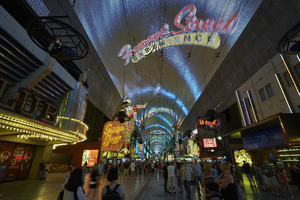
neo000104-001
Description
Notes: The logo cabinets which adorn the entrances on the elevated walkways: The letters start with both rows of text in the off position. The top row flashes on, while the bottom row is dark then the bottom row illuminates, as the top row goes dark. Once the top row flashes off it flashes back on so that both rows of text are briefly illuminated simultaneously before they both go dark and the sequence stars over again. While this is going on the incandescent bulbs which line all of the raceways are chasing each other from left to right on the horizontal planes, while the arched sections chase each other downward. The triangular peaks which radiate around the top of the logo sign, flash on and off in a sequence which chase each other downward. First the top center peak flashes on, then the next sequential triangular channel on both sides illuminate simultaneously, flash off, then the next two in the series illuminate. The resultant effect is a chasing pattern starting from the top. The sister animation is located on almost the exact same design on the porte cochere. I would think the previous smaller sign would be based on the larger porte cochere. The other variance besides obvious size difference is the that the channel letters are filled with incandescent bulbs instead of neon. The animation is a bit simpler as well. The incandescent bulbs oscillate continuously while the triangular pan channels which create the radiating crown, animate. The neon in the channels chase each other as described in the smaller walk way version, while the text continues until the entire text flashes off, then on, off, then begin to animate once again. All of the bulbs, which line the raceways of the exterior edge of the porte cochere, as well as the encrustation of bulbs on the brass bull nose portion, animate in rapid succession. All the raceway bulbs chase each other while the bulbs on the brass portion continually oscillate. Animation continues on the east face of the building with the entrances first. The principle for these two signs is oscillation and chasing. All bulbs on the underside of the entrance, as well as in the logo, oscillate rapidly. All bulbs on the raceways chase each other. Further on the surface of the building as well, the Pepsi cola wall sign is found displaying a very unique form of animation, seen here on the strip. The signage for the Pepsi ad is located on the eastern wall. (Detailed in specific description) The Incandescent bulbs which fill the inside of the text that spells Pepsi, chase each other from left to right, leaving all the bulbs in its path illuminated, as if writing out the word Pepsi. The neon bars located within the tilted bottle of Pepsi are illuminated, and chase each other downward, leaving the bars it its path dark. As this sequence in taking place, the waving tubes of neon illuminate, flashed subtly making the neon appear as soda pouring out of the bottle. As the tubing flows then the vertical neon bars in the cup illuminate one at a time making the cup appear as if it is filling up. The text above each of the painted fires head, flashes back and forth as if talking to each other as well. ESPN ZONE animation: The letters in the vertical blade portion of the ESPN Zone illuminate one at a time, starting from the top. Once the entire phrase is lit, in flashes off then on then off, before restating. The orange and red neon tubing which resides inside the pan channels that represent flames flash on and off in a relaxed manner as if to animate the flickering of the flames. The small incandescent bulbs on the black portions above the main matrix reader board flash on and off subtly.
Sign keywords: Neon; Incandescent; Video screen
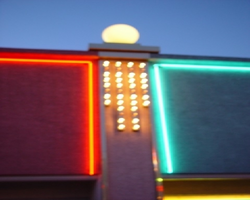
neo000003-004
Description
Notes: The text fascia sign just to the north of the giant glass display illuminates with a background of neon tubing which chases from right to left. The pattern of colors running across are a sequence banks of red, pink purple and blue vertical neon tubing, chase each other creating a pulsating movement of the individual banks of these colors. While they are animating, the channel letters, which spell "Riviera," are dark and proceed to light up one letter at a time. Once all lit they remain lit, until the background stops with all the bars illuminated. Once all the bars are lit, the interiors of the letters turn off one at a time starting on the far right. The giant mirrored section of the building, advertising for the Splash stage show. The sequence can be best described from its dramatic powering up. The entire sign comes alive with a rapid upward chasing pattern covering the surface of the tower. Once alive, small white bulbs grow out of the end of the space on the top and bottom of the end of the "Splash" text. Once all the previous elements are illuminated, the letters in the Splash logo shut off, illuminate one letter at a time in red neon, then the white neon figure of the seal balancing a ball on the end of it's nose, lights up. The neon bordered circular raceway, then animates with the bulbs in the center chasing each other in a clock-wise sequence. Once lit the vast array of white bulbs grown out of the end of the text begin to gently oscillate, as well as the sparse assortment of floating and attached incandescent bulbs on the wall of the tower. Once the bulbs animate for a few seconds, the entire wall chases downward, becoming black as night, except for the Slash logo text. Underneath the entire front side of the western face of the Riviera, the incandescent bulbs which cover the entire surface oscillate in a wildly, while the ringed entablature on the wall animates quietly in comparison. The multi-colored rings of neon tubing chase each other from left to right, chasing the distance then repeating. The sequence then changes direction and chase from left to right. Creating the tops and bottoms of the entablature are raceways lined with incandescent bulbs that chase each other from left to right. On the surface of the west wall incandescent bulbs chase each other along the raceways which run horizontally around the internally lit cabinets. The small vertical raceways which run inside the clear plastic boxes chase each other from top to bottom, but all the raceways are offset to each other by a few seconds. At the North end of the property the signage for the Riviera's, "Nickeltown" gambling attraction, dominates the corner. He animation on the large exploding sculptural fountain lights up the entire corner. The three rocketing pieces of steel are wrapped in repeating bands of their corresponding colors of blue, purple and yellow. All three simultaneously chase from bottom to top, until completely lit. Then they begin to animate in a chasing pattern from bottom to top. After a few moments of chasing, they chase from beginnig to top once more, leaving al the tubes dark in its path. Along the circular entablature, which runs the circumference of the top mass of the fountain, incandescent bulbs chase each other from right to left, but only on the side which faces the casino. The wall, which faces north, contains the multicolored banks of vertical neon bars that animate in a specific pattern. They chase each other from right to left, then only the purple neon tubing illuminates, they chase again, then only the blue neon tubing illuminates. They chase once again, and then only the gold bars illuminate. The bars chase yet one more time, then all of the tubing illuminates, thus ending the sequence. The main entrance to nickel town is adorned with neon text and images, but only the stars higher up on the wall itself animate. The incandescent bulbs elevated above the surface of the mirrored wall, animate in a soft oscillating pattern, adding the twinkling effect. The larger five pointed stars are animated on the interior by a center of oscillating incandescent bulbs, while concentric neon shapes echo outward in the yellow, purple and blue colors seen on the adjacent wall facing north. The smaller snow-flake esque star shapes are alive with oscillating incandescent bulbs. Looking upward along the north face of the closest tower, the giant vertical, Riviera channel letters animate one character at a time, oscillate then shuts off.


